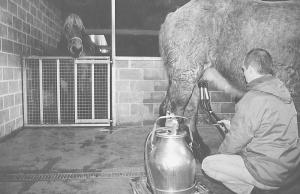2002 - Volume #26, Issue #6, Page #24
[ Sample Stories From This Issue | List of All Stories In This Issue | Print this story
| Read this issue]
Got Horse Milk? These Innovative Farmers Do
 |
 |
They're selling all the horse milk and horse milk products they can produce. They're the largest of some 30 horse and donkey producers in Belgium. There are also a handful of producers in the Netherlands.
Horse milk contains high levels of vitamins A, B1, B2, B6, B12, C and K. It's a good source of iron, potassium, calcium and phosphorus, and several micronutrients. It's low in fat and lactose, but albumin-rich, which makes the milk more easily digestible. It's used for all sorts of reasons, from treating certain diseases to a so-called energy booster.
The Brabanders sell fluid and frozen whole milk, freeze-dried powdered milk, yogurt, ice cream and a plethora of processed products from shampoo and soap to foot and facial creams, balms and aftershave.
According to an article in the Draft Horse Journal, the Brabanders began milking mares in 1997 after a family member, suffering from Crohn's disease (an intestinal disorder) found that drinking a small amount of mare's milk greatly improved his condition.
At the time, the closest place to buy fresh mare's milk was in Holland. Recognizing the potential to sell horse milk, the Brabanders began by milking Belgian Warmblood ponies they already owned. Before long, they switched to Brabants (the original name for Belgian Draft Horses). The larger mares produce nearly twice as much milk as ponies and the mild mannered draft horses are easier to milk than skittish ponies.
The business grew so quickly that by the end of 1997, Nadine left her job to work full time on the horse dairy. Frans followed a few months later. The business has been profitable and continues to grow.
Getting into the horse milking business is relatively easy. No special housing is needed for the milking mares or for their foals. The Brabanders buy mares with foals by their sides. They are kept on pasture with their foals in one big herd.
Mares aren't milked until foals begin eating hay, grass and concentrates, usually at about eight weeks of age. Once the foals begin eating other feeds, the mares can be milked without taking food away from them. Early every morning, the Brabanders separate the mares and foals. During the day, they milk the mares every two-and-a-half hours, usually five times.
They use vacuum milkers similar to those used in milking cows. It takes only a couple of minutes per mare per milking. One minute is spent cleaning and stimulating the mare's udder, which is essential to begin milk flow. Once milk begins dripping from the teats, it takes less than a minute for the automatic milker to do its job. One Brabant mare produces about 1.3 gallons a day.
To assure a more wholesome, more acceptable product, the Brabanders don't use any drugs or other medications on the mares during their lactation periods. Their housing and processing facilities are inspected regularly by health officials.
As far as FARM SHOW can find, there are no horse milk operations in North America.
Contact: FARM SHOW Followup, Frans and Nadine de Brabander - De Hert, Maaikeneveld 66, B-2500 Lier û Belgium (ph 011 32 3 488 24 86; fax 011 32 3 480 79 18; E-mail: info@paardenmelk.be.; Website: www.horsemilkfarm.com).

Click here to download page story appeared in.

Click here to read entire issue
To read the rest of this story, download this issue below or click here to register with your account number.




